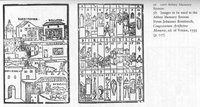(45) Nahuatl dates and playing cards

 In El Jardín de las Delicias/The Garden of Delights, the playing cards in the right panel might be a mnemonic for remembering Murner’s system. They also are part of a tavern scene, which is part of an explanation of the word tabernacle, and it was probably important that the ace of hearts was trampled in the dust. For the moment the most important thing is that an ordinary European deck of cards made a good ready-made model of the way a cycle of 52 years was recorded in Nahuatl picture writing. The sequence 1-Reed, 2-Flint, 3-House, 4-Rabbit could continue for 52 years without repetition following the same pattern as ace of hearts, two of diamonds, three of clubs, four of hearts, and so forth.
In El Jardín de las Delicias/The Garden of Delights, the playing cards in the right panel might be a mnemonic for remembering Murner’s system. They also are part of a tavern scene, which is part of an explanation of the word tabernacle, and it was probably important that the ace of hearts was trampled in the dust. For the moment the most important thing is that an ordinary European deck of cards made a good ready-made model of the way a cycle of 52 years was recorded in Nahuatl picture writing. The sequence 1-Reed, 2-Flint, 3-House, 4-Rabbit could continue for 52 years without repetition following the same pattern as ace of hearts, two of diamonds, three of clubs, four of hearts, and so forth.But the cards are also part of a crime scene, and along with the tally marks on the overturned table and the spilled wine they might be evidence of how a disturbance started. There might be disagreement over whether the fighting started after someone cheated at cards, or after too much drinking.












